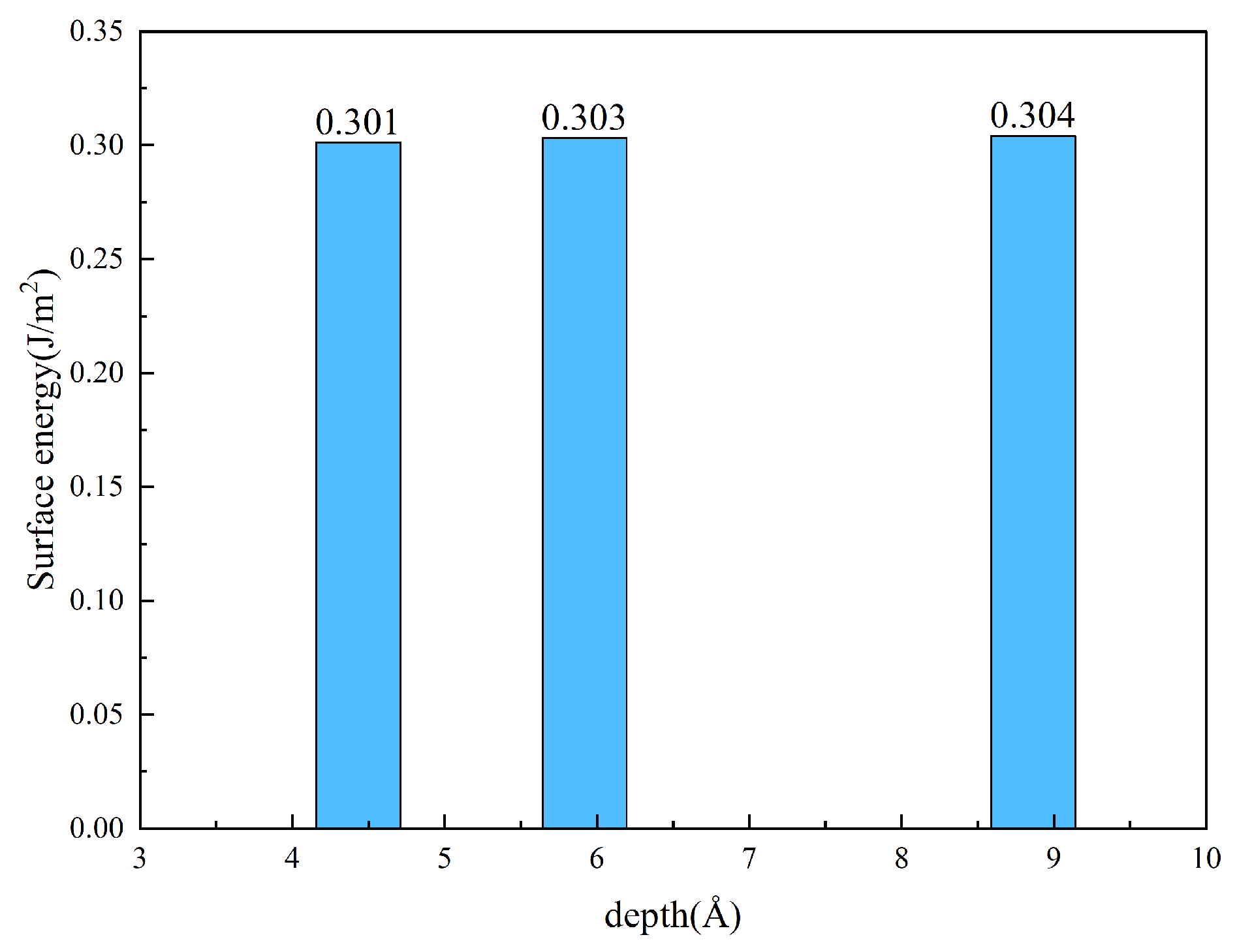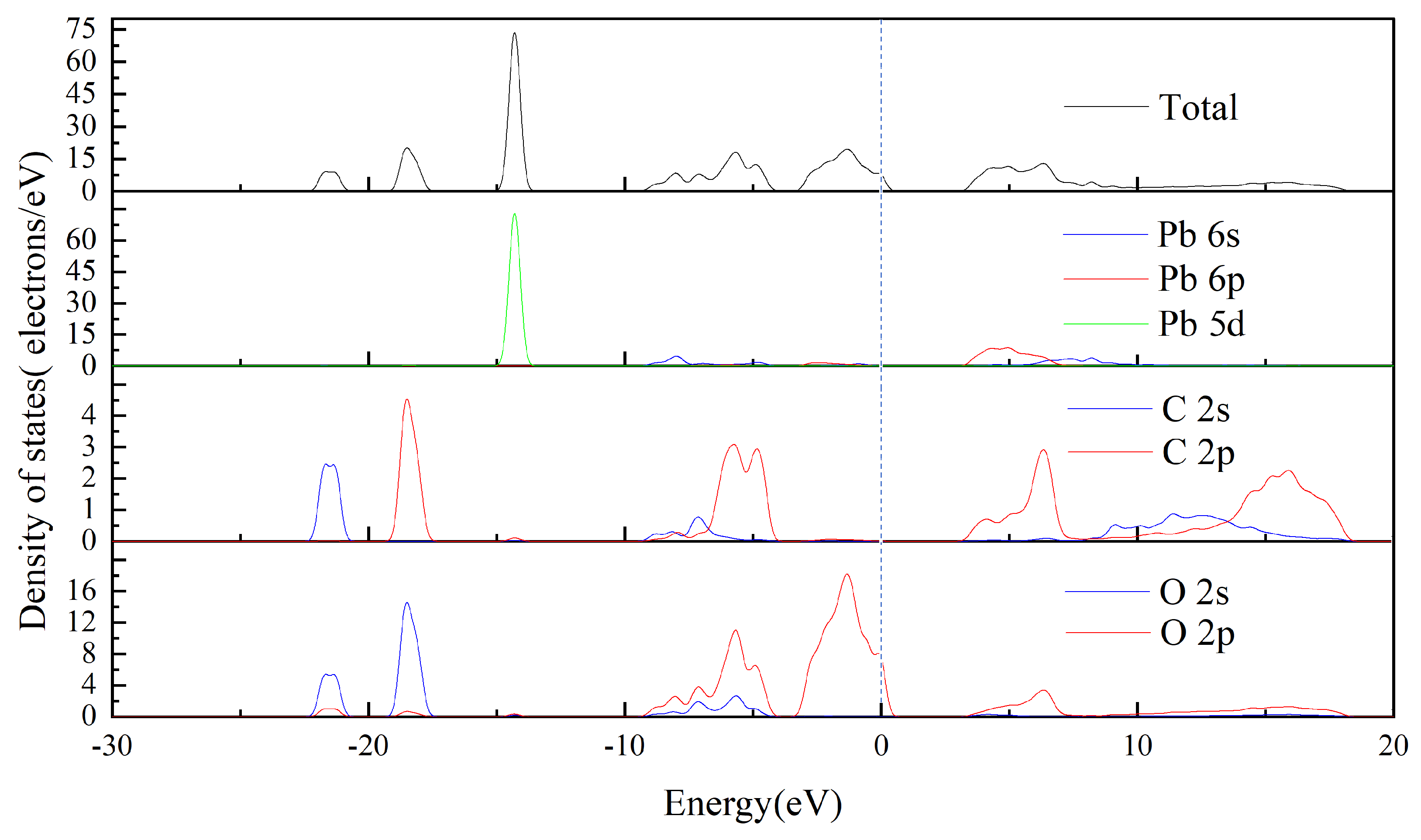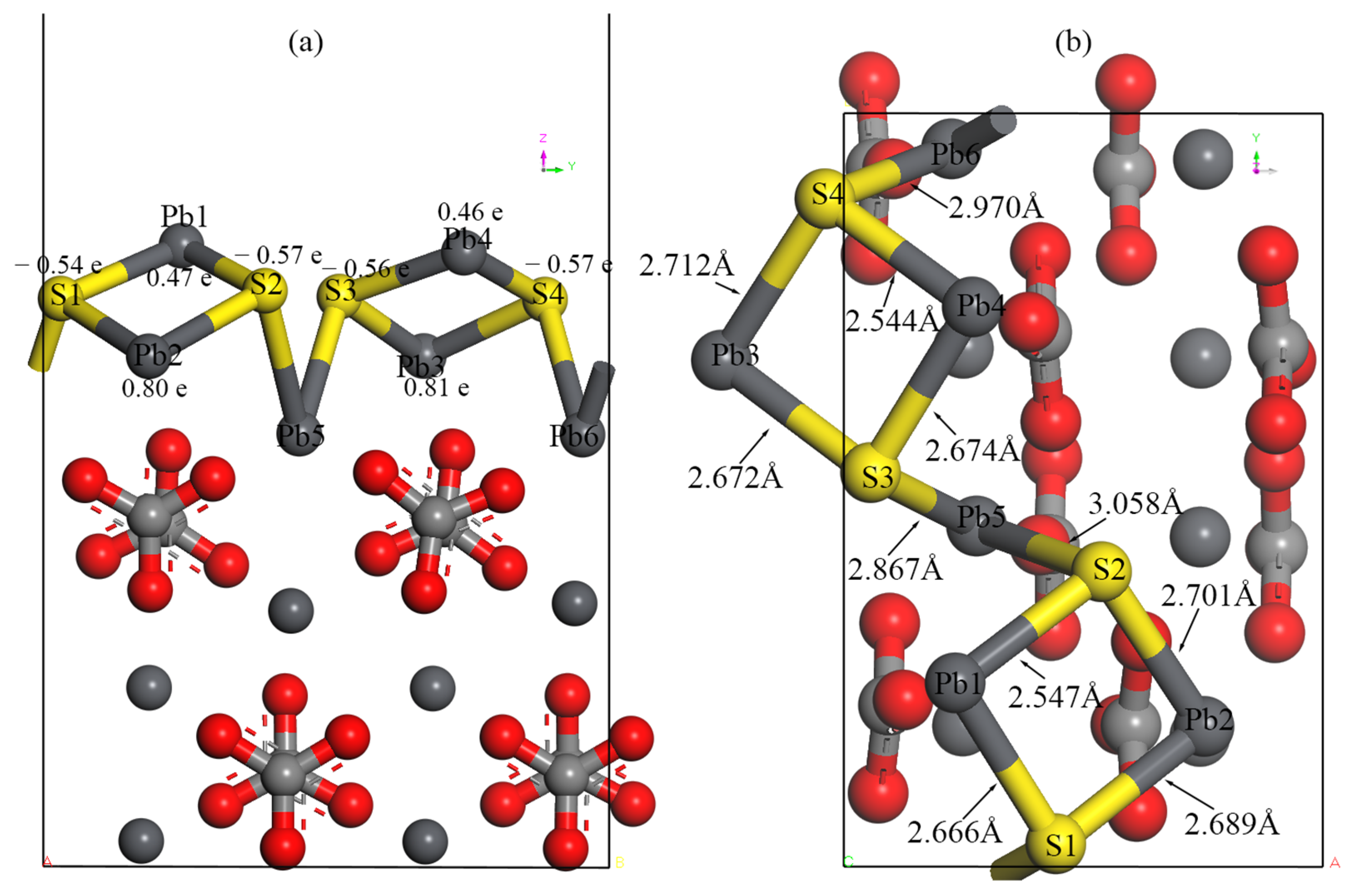Density Functional Theory Study on Structure and Properties of Sulfurized Cerussite (110) Surface
Abstract
:1. Introduction
2. Computational Methods
2.1. Calculation Method and Main Parameters
2.2. Construction of Surface Model
3. Results and Discussion
3.1. Determination of Primarily Parameters
3.2. Geometry and Electronic Structure of Cerussite (110) Plane
3.3. Geometry and Electronic Structure of Sulfurized Cerussite (110) Plane
4. Conclusions
- (1)
- Upon the cleavage of the cerussite crystal along the (110) plane, only the shallow-layer atoms near the newly formed surface undergo relaxation to reconstruct the surface, resulting in a surface energy of approximately 0.3 J/m2.
- (2)
- Only the surface-layer Pb atoms of the cerussite (110) plane react with the sulfuring agent to form PbS, which forms a structure similar to galena on the cerussite surface. The Pb-S bond length in the newly formed PbS layer is shorter than in galena, and the Pb-S bonds formed between S atoms in the newly formed PbS layer and Pb atoms in the cerussite lattice have longer bond lengths, approaching that observed in galena.
- (3)
- The density of states of the Pb atoms on the sulfurized cerussite (110) surface increases near the Fermi level compared with that of the Pb atoms of the cerussite (110) plane, resulting in the former being more easily adsorbed by a flotation reagent such as xanthate.
- (4)
- The Pb atoms of the sulfide layer that are relatively distant from the lead oxide structure have their 6s and 6p orbital electrons occupying energy levels closer to the Fermi level than those of Pb atoms that are in closer proximity to the lead oxide structure, indicating that these orbital electrons show stronger localization, which implies that electron transfer between Pb and the polar groups of flotation reagents occur more easily.
Author Contributions
Funding
Data Availability Statement
Conflicts of Interest
References
- Geoffrey, J. May, Alistair Davidson and Boris Monahov, Lead batteries for utility energy storage: A review. J. Energy Storage 2018, 15, 145–157. [Google Scholar] [CrossRef]
- AbuAlRoos, N.J.; Amin, N.A.B.; Zainon, R. Conventional and new lead-free radiation shielding materials for radiation protection in nuclear medicine: A review. Radiat. Phys. Chem. 2019, 165, 108439. [Google Scholar] [CrossRef]
- Chen, L.; Li, T.; Zhang, J.; Wang, Y.; Kong, L.; Xu, B.; Yang, B.; Wu, M. Modeling and measurement of vapor-liquid equilibrium of In–Pb and In–Pb–Sn alloy systems in vacuum distillation. Vacuum 2023, 207, 111556. [Google Scholar] [CrossRef]
- Chen, Y.; Sun, Y.; Han, Y. Efficient flotation separation of lead–zinc oxide ores using mineral sulfidation reconstruction technology: A review. Green Smart Min. Eng. 2024, 1, 175–189. [Google Scholar] [CrossRef]
- Westner, K.J.; Vaxevanopoulos, M.; Blichert-Toft, J.; Davis, G.; Albarède, F. Isotope and trace element compositions of silver-bearing ores in the Balkans as possible metal sources in antiquity. J. Archaeol. Sci. 2023, 155, 105791. [Google Scholar] [CrossRef]
- Li, S.; Shi, Q.; Li, B.; Yu, Y. Separation of cerussite and calcite by flotation using tert-butylbenzylhydroxamic acid collector and insights to its adsorption mechanism. J. Mol. Liq. 2024, 407, 125271. [Google Scholar] [CrossRef]
- Li, Y.; Wang, J.-K.; Wei, C.; Liu, C.-X.; Jiang, J.-B.; Wang, F. Sulfidation roasting of low grade lead–zinc oxide ore with elemental sulfur. Miner. Eng. 2010, 23, 563–566. [Google Scholar] [CrossRef]
- Moradi, S.; Monhemius, A.J. Mixed sulphide–oxide lead and zinc ores: Problems and solutions. Miner. Eng. 2011, 24, 1062–1076. [Google Scholar] [CrossRef]
- Önal, G.; Bulut, G.; Gül, A.; Kangal, O.; Perek, K.T.; Arslan, F. Flotation of Aladaǧ oxide lead–zinc ores. Miner. Eng. 2005, 18, 279–282. [Google Scholar] [CrossRef]
- Wei, Q.; Dong, L.; Qin, W.; Jiao, F.; Qi, Z.; Feng, C.; Sun, D.; Wang, L.; Xiao, S. Efficient flotation recovery of lead and zinc from refractory lead-zinc ores under low alkaline conditions. Geochemistry 2021, 81, 125769. [Google Scholar] [CrossRef]
- Sotillo, F.J.; Herrera-Urbina, R.; Fuerstenau, D.W. Amyl xanthate uptake by natural and sulfide-treated cerussite and galena. Int. J. Miner. Process. 1998, 55, 113–128. [Google Scholar] [CrossRef]
- Sánchez-Navas, A.; López-Cruz, O.; Velilla, N.; Vidal, I. Crystal growth of lead carbonates: Influence of the medium and relationship between structure and habit. J. Cryst. Growth 2013, 376, 1–10. [Google Scholar] [CrossRef]
- Ye, Y.; Smyth, J.R.; Boni, P. Crystal structure and thermal expansion of aragonite-group carbonates by single-crystal X-ray diffraction. Am. Mineral. 2012, 97, 707–712. [Google Scholar] [CrossRef]
- Elizondo-Álvarez, M.A.; Uribe-Salas, A.; Nava-Alonso, F. Flotation studies of galena (PbS), cerussite (PbCO3) and anglesite (PbSO4) with hydroxamic acids as collectors. Miner. Eng. 2020, 155, 106456. [Google Scholar] [CrossRef]
- Zheng, Y.-X.; Bao, L.-Y.; Lv, J.-F.; Pang, J.; Hu, P.-J.; Huang, Y.-S. Flotation response of cerussite after hydrothermal treatment with sulfur and the sulfidation mechanism. J. Mater. Res. Technol. 2021, 15, 2933–2942. [Google Scholar] [CrossRef]
- Herrera-Urbina, R.; Sotillo, F.J.; Fuerstenau, D.W. Effect of sodium sulfide additions on the pulp potential and amyl xanthate flotation of cerussite and galena. Int. J. Miner. Process. 1999, 55, 157–170. [Google Scholar] [CrossRef]
- Li, C.-X.; Wei, C.; Deng, Z.-G.; Li, X.-B.; Li, M.-T.; Xu, H.-S. Hydrothermal Sulfidation and Flotation of Oxidized Zinc-Lead Ore. Metall. Mater. Trans. B 2014, 45, 833–838. [Google Scholar] [CrossRef]
- Feng, Q.; Wen, S.; Deng, J.; Zhao, W. Combined DFT and XPS investigation of enhanced adsorption of sulfide species onto cerussite by surface modification with chloride. Appl. Surf. Sci. 2017, 425, 8–15. [Google Scholar] [CrossRef]
- Chen, J.; Lan, L.; Chen, Y. Computational simulation of adsorption and thermodynamic study of xanthate, dithiophosphate and dithiocarbamate on galena and pyrite surfaces. Miner. Eng. 2013, 46–47, 136–143. [Google Scholar] [CrossRef]
- Karamoozian, M.; Karamoozian, M. Proposing a seven-parameter kinetics model for predicting cerussite flotation recovery. Int. J. Min. Geo-Eng. 2020, 54, 1–12. [Google Scholar] [CrossRef]
- Li, J.; Liu, S.; Liu, D.; Liu, R.; Liu, Z.; Jia, X.; Chang, T. Sulfidization mechanism in the flotation of cerussite: A heterogeneous solid-liquid reaction that yields PbCO3/PbS core-shell particles. Miner. Eng. 2020, 153, 106400. [Google Scholar] [CrossRef]
- Liu, C.; Zhang, W.; Song, S.; Li, H.; Jiao, X. A novel insight of the effect of sodium chloride on the sulfidization flotation of cerussite. Powder Technol. 2019, 344, 103–107. [Google Scholar] [CrossRef]
- Moimane, T.; Peng, Y. Sulphidisation of oxides and oxidised sulphides and adsorption of thiol collectors on the sulphidised products-a critical review. Adv. Colloid Interface Sci. 2020, 305, 102697. [Google Scholar] [CrossRef] [PubMed]
- Fuerstenau, M.C.; Olivas, S.A.; Herrera-Urbina, R.; Han, K.N. The surface characteristics and flotation behavior of anglesite and cerussite. Int. J. Miner. Process. 1987, 20, 73–85. [Google Scholar] [CrossRef]
- Zhang, Q.; Wen, S.; Zhang, S.; Feng, Q. Surface chemistry of dissolved species of cerussite and calcite and its effect on flotation performance. Colloids Surf. A Physicochem. Eng. Asp. 2022, 646, 128945. [Google Scholar] [CrossRef]
- Tang, X.; Chen, J.; Chen, Y. A density functional based tight binding (DFTB+) study on the sulfidization-xanthate flotation mechanism of cerussite. Appl. Surf. Sci. 2023, 612, 155677. [Google Scholar] [CrossRef]
- Richard, D.; Rendtorff, N.M. Kaolin group minerals under pressure: The study of their structural and electronic properties by DFT methods. Appl. Clay Sci. 2022, 219, 106444. [Google Scholar] [CrossRef]
- Cui, W.; Chen, J. Insight into mineral flotation fundamentals through the DFT method. Int. J. Min. Sci. Technol. 2021, 31, 983–994. [Google Scholar] [CrossRef]
- Sarvaramini, A.; Larachi, F.; Hart, B. Collector attachment to lead-activated sphalerite—Experiments and DFT study on pH and solvent effects. Appl. Surf. Sci. 2016, 367, 459–472. [Google Scholar] [CrossRef]
- Mangwejane, S.S.; Mkhonto, P.P.; Ngoepe, P.E. Comparison of adsorption capacity of water and hydroxide with collector reagents on geversite (PtSb2) mineral surface: A DFT-D insights. Comput. Mater. Sci. 2023, 224, 112174. [Google Scholar] [CrossRef]
- Zhang, X.; Fang, J.; Feng, Y.; Zhang, J.; Guo, R.; Chen, J. The mechanism of water decomposition on surface of aluminum and gallium alloy during the hydrogen production process: A DFT study. Int. J. Hydrogen Energy 2024, 66, 354–361. [Google Scholar] [CrossRef]
- Zhao, C.; Zhou, X.; Chen, J. Ethyl xanthate adsorption on different surfaces of jamesonite: A DFT study. Appl. Surf. Sci. 2024, 663, 160135. [Google Scholar] [CrossRef]
- Antao, S.M.; Hassan, I. The Orthorhombic Structure of CaCO3, SrCO3, PbCO3 AND BaCO3: Linear Structural Trends. Can. Mineral. 2009, 47, 1245–1255. [Google Scholar] [CrossRef]
- Han, C.; Li, T.; Zhang, W.; Zhang, H.; Zhao, S.; Ao, Y.; Wei, D.; Shen, Y. Density Functional Theory Study on the Surface Properties and Floatability of Hemimorphite and Smithsonite. Minerals 2018, 8, 542. [Google Scholar] [CrossRef]
- Perdew, J.P.; Burke, K.; Ernzerhof, M. Generalized Gradient Approximation Made Simple. Phys. Rev. Lett. 1996, 77, 3865–3868. [Google Scholar] [CrossRef] [PubMed]
- Hammer, B.; Hansen, L.B.; Norskov, J.K. Improved adsorption energetics within density-functional theory using revised Perdew-Burke-Ernzerhof functionals. Phys. Rev. B 1999, 59, 7413. [Google Scholar] [CrossRef]
- Perdew, J.P.; Chevary, J.A.; Vosko, S.H.; Jackson; Jackson, K.A.; Pederson, M.R.; Singh, D.J.; Fiolhais, C. Atoms, molecules, solids, and surfaces: Applications of the generalized gradient approximation for exchange and correlation. Phys. Rev. B 1993, 46, 6671. [Google Scholar] [CrossRef] [PubMed]
- Wu, Z.; Cohen, R.E. More accurate generalized gradient approximation for solids. Phys. Rev. B 2006, 73, 235116. [Google Scholar] [CrossRef]
- Perdew, J.P.; Ruzsinszky, A.; Csonka, G.I.; Vydrov, O.A.; Scuseria, G.E.; Constantin, L.A.; Zhou, X.; Burke, K. Restoring the Density-Gradient Expansion for Exchange in Solids and Surfaces. Phys. Rev. Lett. 2008, 100, 136406. [Google Scholar] [CrossRef]
- Kang, J.; An, Y.; Xue, J.; Ma, X.; Li, J.; Chen, F.; Wang, S.; Wan, H.; Zhang, C.; Bu, X. Density Functional Theory Study of the Electronic Structures of Galena. Processes 2023, 11, 619. [Google Scholar] [CrossRef]






| Functionals | Lattice Constant | Difference/% | |||
|---|---|---|---|---|---|
| a/Å | b/Å | c/Å | |||
| Experimental | 5.1832 | 8.4492 | 6.1475 | ||
| Simulation | GGA-PBE [35] | 5.2140 | 8.4673 | 6.2855 | 3.215 |
| GGA-RPBE [36] | 5.3763 | 8.5006 | 6.9485 | 16.771 | |
| GGA-PW91 [37] | 5.2052 | 8.4496 | 6.2499 | 2.674 | |
| GGA-WC [38] | 5.1232 | 8.4041 | 6.0907 | 3.201 | |
| GGA-PBESOL [39] | 5.1258 | 8.4029 | 6.0904 | 3.169 | |
| K-Mesh Density | Lattice Constant | Difference/% | |||
|---|---|---|---|---|---|
| a/Å | b/Å | c/Å | |||
| Experimental | 5.1832 | 8.4492 | 6.1475 | ||
| Simulation | 1 × 1 × 1 | 5.3117 | 10.8946 | 4.7890 | 52.759 |
| 2 × 1 × 2 | 5.2052 | 8.4496 | 6.2499 | 2.674 | |
| 3 × 2 × 2 | 5.2106 | 8.4794 | 6.2434 | 2.320 | |
| 4 × 3 × 2 | 5.2104 | 8.4815 | 6.2416 | 2.264 | |
| 5 × 3 × 2 | 5.2091 | 8.4823 | 6.2398 | 2.200 | |
| Cutoff Energy/eV | Lattice Constant | Difference/% | |||
|---|---|---|---|---|---|
| a/Å | b/Å | c/Å | |||
| Experimental | 5.1832 | 8.4492 | 6.1475 | ||
| Simulation | 600 | 5.2385 | 8.4646 | 6.3399 | 4.605 |
| 650 | 5.2148 | 8.4696 | 6.2919 | 3.306 | |
| 680 | 5.2235 | 8.4383 | 6.3030 | 4.023 | |
| 700 | 5.2052 | 8.4496 | 6.2499 | 2.674 | |
| 720 | 5.2019 | 8.4424 | 6.2513 | 2.717 | |
Disclaimer/Publisher’s Note: The statements, opinions and data contained in all publications are solely those of the individual author(s) and contributor(s) and not of MDPI and/or the editor(s). MDPI and/or the editor(s) disclaim responsibility for any injury to people or property resulting from any ideas, methods, instructions or products referred to in the content. |
© 2024 by the authors. Licensee MDPI, Basel, Switzerland. This article is an open access article distributed under the terms and conditions of the Creative Commons Attribution (CC BY) license (https://creativecommons.org/licenses/by/4.0/).
Share and Cite
Han, C.; Ao, Y.; Shen, Y.; Zhao, S.; Zhao, Q.; Zhou, S. Density Functional Theory Study on Structure and Properties of Sulfurized Cerussite (110) Surface. Minerals 2024, 14, 801. https://doi.org/10.3390/min14080801
Han C, Ao Y, Shen Y, Zhao S, Zhao Q, Zhou S. Density Functional Theory Study on Structure and Properties of Sulfurized Cerussite (110) Surface. Minerals. 2024; 14(8):801. https://doi.org/10.3390/min14080801
Chicago/Turabian StyleHan, Cong, Yuxin Ao, Yanbai Shen, Sikai Zhao, Qiang Zhao, and Shijie Zhou. 2024. "Density Functional Theory Study on Structure and Properties of Sulfurized Cerussite (110) Surface" Minerals 14, no. 8: 801. https://doi.org/10.3390/min14080801





